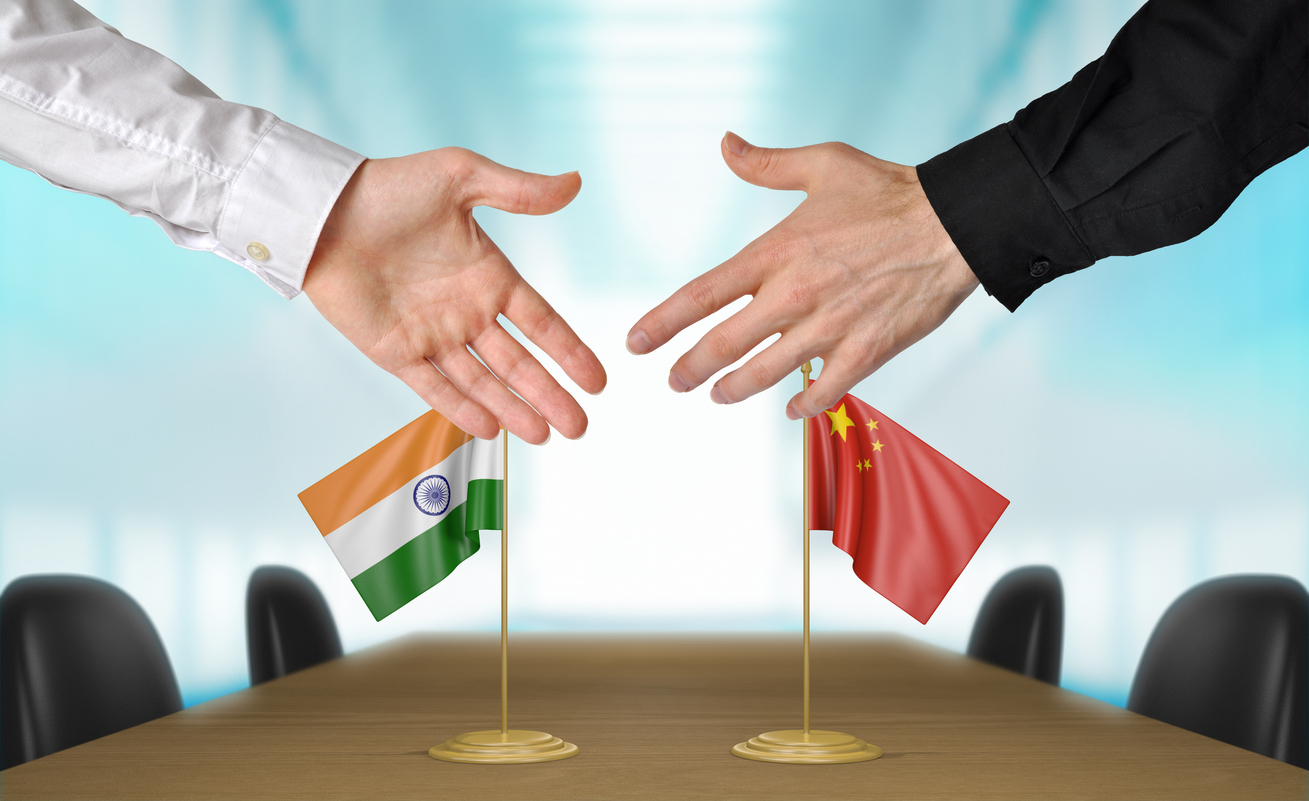
ARE WE HEADED FOR POSITIVE TIMES IN THE SINO INDIAN RELATIONSHIP ?
 Thu, 25 Apr 2024
| Reading Time: 5 minutes
Thu, 25 Apr 2024
| Reading Time: 5 minutes

“I hope and believe that through positive and constructive bilateral engagement at the diplomatic and military levels, we will be able to restore and sustain peace and tranquility in our borders,” said Prime Minister Modi recently in reference to a question on China and the India-China border dispute. He was responding to a set of questions in an interview with the high-profile Newsweek magazine. It was a long and extremely comprehensive interview, which covered much ground on the achievements of his government and the challenges that he faced in the last ten years. However, what caught the eye of most keen observers of international geopolitics was the Prime Minister’s above statement. It was after long that he had spoken about China. That is why it created some ripples, especially because of the positive stance he adopted.
There is general awareness of the initial efforts made by the Modi government to improve relations with China and bring about greater cooperation between the two countries. That was the logical thing to do when economic development on a fast track was and is India’s desire. Conflict and border tension is the last thing that contributes to such aspirations, although a balance in the domain of national security is always to be maintained as part of contingency planning. With a pragmatic approach India and China progressed their relationship for almost six years under the leaderships of PM Modi and President Xi Jinping before things suddenly went southwards, with some initial hiccups due to the Doklam standoff in 2017.
It was at the height of the pandemic in April 2020 that China took a decision to overturn all the positive gains of six years and adopt a policy of military coercion on the Line of Actual Control (LAC) in Ladakh. It was against the run of the strategic play which seemed to be developing positively despite the odd hiccup. The Apr 2020 incidents restored an old dictum which dictated the relationship; it goes by the understanding that the Sino Indian relationship has always been stricken by the doubt whether the two nations are friends, adversaries, partners or competitors. The existence of a bit of everything dispels the build-up of trust.
Through the four years after the triggering of the standoff at the LAC in Ladakh there is a continuing military and diplomatic engagement taking place between both nations which has diluted some of the tensions, but China does not appear to treat this with full seriousness. Reacting to PM Narendra Modi’s statement, the Chinese official mouthpiece Global Times wrote in a recent editorial that Modi’s remarks on China-India relations under reference are thought-provoking. More specifically it said – “Modi’s interview has sent out quite positive signals regarding China-Indian relations. It corrects the recent heating-up trend of India’s attitude and actions on border issues, demonstrating a willingness to pragmatically resolve problems and ease bilateral relations.” Blaming India has always been a part of the Global Times strategy, so it is good to see a reasonably positive response in the same breath from the Chinese official organ.
When Prime Minister Narendra Modi came to power in 2014, he infused a more positive note in India’s relationship with China. He had good experience in the exchanges he had in various areas of economic cooperation while he had occupied the office of Chief Minister of Gujarat. As Prime Minister these exchanges continued with the Chinese President reflecting a mature approach to problem solving and taking the development and cooperation agenda well forward; there were murmurs of the relationship turning transformational. The Doklam standoff in 2017, however, tested the emerging equation as the Indian Army and the People’s Liberation Army (PLA) clashed at the trijunction of the India-Bhutan-China border in Sikkim. The 72 days faceoff ended without any indicators of how the issue would be addressed later since it was well known that China had decided to discontinue the standoff in light of the BRICS summit it was hosting later that year and the 19th Congress of the Chinese Communist Party.
In Apr-May 2020, even as China and much of the world reeled under the impact of the Coronavirus pandemic, the PLA decided to convert a large-scale exercise in the Tibetan heartland into an operational military manoeuvre to occupy positions along the LAC and threaten a virtual invasion of Eastern Ladakh. The Indian Army and Air Force responded rapidly to bring 50,000 troops to Eastern Ladakh to execute a faceoff. On 15 Jun 2020, the Galwan incident occurred which saw loss of lives on both sides and the crisis became a full-blown standoff which could have resulted in a major conflagration. Better sense prevailed and an engagement process already initiated was firmly put on track to try and bring about the status quo ante. That has been a challenge and China seems to continue with its strategy of ‘salami slicing’.
Salami slicing is defined as – “a series of actions to remove or reduce something by small amounts over a period of time”. Its application at the LAC has seen the PLA take incremental steps to occupy ground and then vacate some parts of it as a projected favour to India. It also attempts to define its claims by aggressive patrolling and denial of movement to some areas by Indian troops. No specific claims have ever been made about the alignment of its claim lines run and India’s requests for marked maps have never been responded to. Keeping the entire strategy in the zone of grey is apparently perceived as a strategic advantage by China and forms the bedrock of its policy towards India.
This analysis will be incomplete without mention of the ‘continental versus maritime’ theory, an understanding that I have often included in detail in some of my strategic writings. Very briefly, the understanding is that China feels confident of militarily handling India in the continental domain of the high Himalayas but is not as confident of the maritime domain where the PLA Navy has to struggle to project itself as a blue water navy while its capability remains limited to the brown water variety. Activating the continental domain prevents India from focusing on a more proactive maritime strategy.
In the light of the above strategy and the positive stance adopted by India through the important statement made by Prime Minister Modi, should we expect a change in the run of play in Sino Indian relations. The Indian policy is on the right lines. It’s the trust deficit which has pushed the Sino Indian relationship to awkward straits. Xi Jinping could not correctly gauge the sincerity and good intent of the Indian Prime Minister who aimed to free the relationship from contextualization with other powers, middle or big. The relationship would follow the rule-based charter for mutual benefit. What probably worried China and constrained its thinking is the rapid strides India made in strategic decision making, something which had placed India on the way to greater strategic significance. China’s perception probably revolved around witnessing India as weak and vacillating, incapable of looking inwards and actively pursuing its interests. Rising strategic importance of India triggered concern and the period of the pandemic was considered suitable for pressurizing India. In the cascade of events at the LAC things went haywire and led to the unfortunate Galwan incident. China probably perceives that the current deployment at the LAC in Ladakh, the frequent parleys at the Corps Commanders level, some degree of proactive demonstration through information channels and building the grey zone even more grey, serves its strategic purpose, for now.
Serving the Chinese purpose in the current strategic environment essentially means the parrying of a strategy for the moment until more conducive times. The wars in Ukraine and Gaza have pulled the US and NATO interests in those directions leaving China free to strategise for Southeast Asia. South Asia can be a much bigger pull-on PLA resources if anything goes out of hand. Yet China would not like to cede a perceived advantage to India by pulling back from the offensive stance that it adopted since 2020. Thus, while expressing a positive response to PM Modi’s thoughts China may not wish to go any further at this juncture. It would study Indian media and expressions by analysts before incrementally taking the next step.
There may be a tendency on part of some analysts to be critical of those who have taken PM Modi’s stance as a positive development. Actually, each such expression in an environment of such tension means much and each side will wish to be correct in the reading of the strategic mood in the other. For now, the strategic mood in India is positive but just sufficient. Next gestures should be waited for more outcomes. In the season of chess there remains hope and scope for more.
Disclaimer
The opinions expressed in this article are the author’s own and do not reflect the views of Chanakya Forum. All information provided in this article including timeliness, completeness, accuracy, suitability or validity of information referenced therein, is the sole responsibility of the author. www.chanakyaforum.com does not assume any responsibility for the same.
Chanakya Forum is now on . Click here to join our channel (@ChanakyaForum) and stay updated with the latest headlines and articles.
Important
We work round the clock to bring you the finest articles and updates from around the world. There is a team that works tirelessly to ensure that you have a seamless reading experience. But all this costs money. Please support us so that we keep doing what we do best. Happy Reading
Support Us





















POST COMMENTS (0)